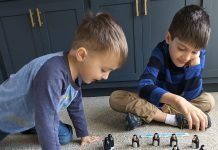Inside this family of four’s living room, a collection of decorative letters spans the length of the fireplace mantle. Trying to understand their meaning can be perplexing at first:
“JKAOBERINI …?”
But if you’re in their home very long, you’ll realize these letters spell no word, yet they tell many stories nonetheless. Each letter represents the name of a child who has lived with this family, who has been part of their daily lives for days, months, or even years, and who is still very much remembered and loved.
Kansas City mom Kelly C. has been a foster parent for five years, during which her family has taken in eight foster children for long-term placements, plus many others for short-term stays.
She and her husband started considering foster care after working with foster children through their jobs. Kelly is a social worker, and her husband formerly taught in inner city Chicago.
Kelly says, “Like all teachers and social workers, we wanted to help! But we quickly realized that the little bit of help we could offer during our work day wasn’t enough to replace a consistent, loving home environment.”
The couple talked with trusted friends, asking if they thought fostering might be a good fit for their family. When their friends encouraged them to start the process – and agreed to support them along the way – Kelly and her husband began taking licensing classes. They accepted their first placement in September 2010.
At the time, Kelly was a stay-at-home-mom to two young children — then ages four and two — and she already had experience working with troubled youth. She didn’t anticipate the surprises foster care would bring.
“I thought that if I brought a child into my warm, safe, loving home, then I could help ‘save’ them, in some sense. But our very first placement rocked our worlds and helped me realize very quickly that helping kids who have been through trauma is hard. Very, very hard.”
If biological parenting brings hundreds of unpredictable moments, then foster parenting intensifies this exponentially: foster parents literally welcome a child into their home in a moment – usually in a moment of crisis, for which no one can be fully prepared.
When a foster parent receives news of a child needing a place to live, they typically have no car seat pre-installed in her car, no new baby gifts in the nursery and no maternity leave planned. They simply drop what they are doing to prepare for a child’s arrival: making beds, locating up-to-date car seats, arranging for daycare or school drop-offs, preparing their own kids to welcome another child to the family, and clearing their schedule to be available for dozens of appointments, such as court dates, doctor’s visits, and case worker meetings.
These are only the logistics. Aside from providing for the basic needs of their foster children, foster parents also do the hard work of entering into a child’s often-difficult story, and navigating their grief or pain. They provide daily encouragement, love, and stability. They regularly put their own comfort and convenience aside for the sake of children who need a home.
Many people think foster parents are only fostering in order to adopt or expand their family. That’s true in some cases, as about 30% of foster placements do result in adoption. Fostering to adopt is particularly a need for kids ages seven or older, sibling groups of three or more, and for children with special needs.
But in most cases, the child will eventually return to live with their biological parent. Kelly says this makes the goal of foster care much bigger and harder than most people realize. It’s not just about the kids; it’s about entire family restoration.
“My ideas have changed a lot about the goal of foster care,” Kelly says. “We now think of foster care as not only caring for the kids, but also building a relationship with parents, so that we can become a resource for them. In order for a traumatized kid to experience healing, there needs to be whole family healing and restoration. Otherwise, foster care is just front line triage – bandaging up the kids wounds and then sending them back to battle.”
After fostering eight children – and having to say “goodbye” to all of them – Kelly’s family still feels called to be involved in this work, knowing that the need is great, and that it makes a difference for families in our community.
As Kelly says, “My hope [at the end of a placement] is that we’ve helped improve the kids’ lives in some way. They may be simple improvements, like they have new clothes and are all caught up on their immunizations, or huge ones, like their parents are no longer addicts. We can’t control what choices their biological family makes, or what choices the child welfare system makes – but at least while they lived at my house, they were fed, clothed, cuddled, encouraged, prayed for, played with, and saw a mom and a dad who consistently loved … things that my kids don’t even give a thought to, but for a child who has been raised in poverty and chaos, are a big deal.”
Kelly is also quick to point out that foster parents can’t do this work alone. Foster families depend on their family, friends, neighbors, church community and other foster parents. Having a strong support system around them enables foster parents to succeed in the work that they are called to do.
In light of that, Kelly is an advocate for other families who want to help kids in our city. Something I have learned from her is that anyone can get involved in caring for foster families and at-risk youth, and that we all have resources to share. Consider one of the following ways to get involved:
- Become a support to a child who is in danger of entering the child welfare system. As Kelly says, “The best time to help a child and family is before they become a foster child.” Safety net organizations like Big Brothers Big Sisters or Boys and Girls Club are good places to help improve the lives of families in poverty.
- Volunteer with CASA, and become a court-appointed special advocate. CASAs get to know a foster child,and listen to what they say, in order to act as their advocate in court.
- Get to know foster families around you, and ask how you can support them.
- Become licensed to provide respite care (foster care for a short time period).
- If you have a strong community of support around you and are ready to become a licensed foster parent, contact an agency such as MFCAA or MBCH to begin the licensing process.


















